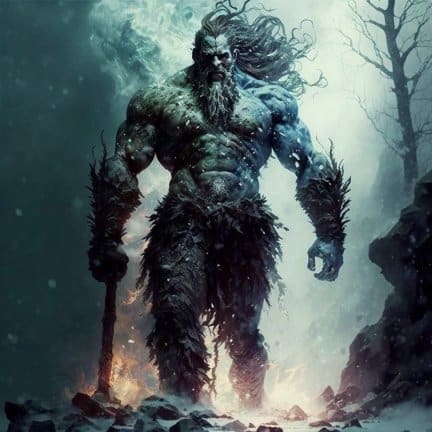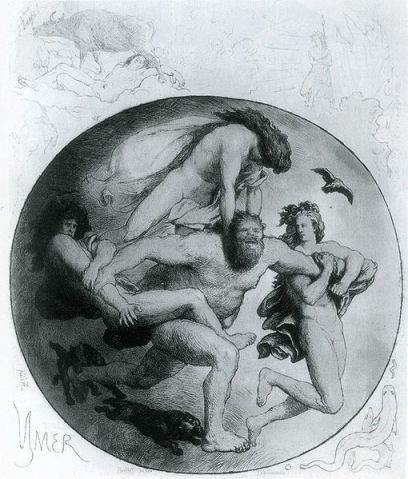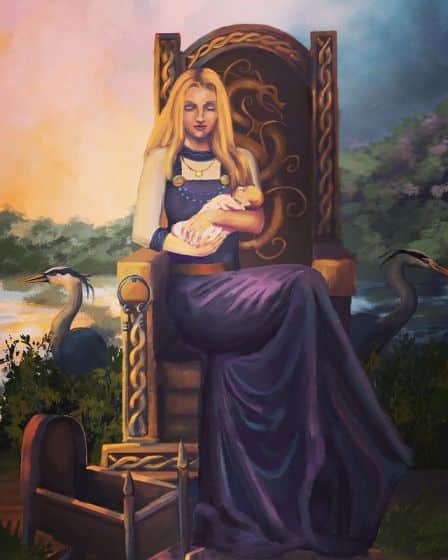Norse mythology fascinated me even as a child, but back then it seemed much simpler. The good Aesir gods created earth and protected it and the humans from the evil jötnar. Little did I know that Ymir, the first of the giants, not only fathered the jotnar, but also was an ancestor of the gods. Living at first only with the primordial cow Audhumla, Ymir soon was joined by Búri, first of the gods.
The mythological tales of Ymir and Bestla provide insights into the origins and development of the Norse cosmos. Moreover they are key figures in the genesis of the gods and giants, their roles are central to understanding the complex narrative that characterizes Norse mythology.
Ymir – The primordial Jötun, first of the giants

Ymir’s story begins at the dawn of creation in Norse mythology. As one of the first beings to exist, Ymir emerged from the primordial cosmic void of Ginnungagap. It was brought into being by the collision of fire and ice from the realms of Muspelheim and Niflheim. Ymir is the progenitor of the frost giants, known as the Jötnar, and plays a crucial role in the formation of the cosmos.
Ymir and his world in the Ginnungagap is described in the poem Völuspá, stanza 3
Old Norse:
“Ár var alda,
þar er Ymir bygði,
vara sandr né sær,
né svalar unnir;
jörð fannsk æva
né upphiminn;
gap var ginnunga,
en gras hvergi.”
English Translation:
“In earliest times,
did Ymir live:
was nor sea nor land,
nor salty waves,
neither earth was there,
nor upper heaven,
but a gaping nothing,
and green things nowhere.”
Birth of the giants
Being the first of his kind and with no other to mate with, the first giants came straight from Ymir himself. This is described in chapter four of the Gylfaginning.
Gylfaginning, chapter 4 (from the Prose Edda)
Old Norse:
“Þá er hann svaf, þá fell hann svimi, ok svá er sagt at þá vóx undir hans vinstri hönd kona ok karl, ok því næst váru fætr hans saman ok vóx af því einir sex höfuð. Þat er kyn þat, er hrímþursar heita. En því næst var þat, er sá kýr var licked steinana, er saltir váru, at þann dag er hann fæddr var, þá tók hann kviknað ok lét þá steinana ok tók þá mjólk af sér, ok þá drakk Ymir.”
English Translation:
“Then, while he slept, he sweated, and from the sweat under his left hand, a male and a female grew forth, and from his feet together, another six-headed one grew. This is the kind that is called frost giants. And next, when the cow licked the stones, which were salty, on that day he was born, he took life and left the stones and took milk from her, and Ymir drank.”
From these first three jotnar, all other giants are descended. As I’ll soon get to, the Aesir gods as well descend from Ymir, at least in part.
The slaying of Ymir
Ymir’s significance in Norse mythology cannot be overstated, as his body later becomes the very building blocks of the world.
From the beginning of time, there was tension between the giants and the Aesir gods. The jotnar represented cruelty, savagery and chaos and the gods saw them (mostly) as an evil force. This culminated later when Borr and Bestla’s children Odin, and his two brothers Vili and Ve attacked and killed Ymir.

After they had killed Ymir, they used his body to create Midgard, his blood to form the oceans, and his bones and teeth to fashion the mountains and rocks. As the source of creation, Ymir’s role in Norse mythology is paramount.
This is significant on several levels, not least because Bestla, the mother of Odin, Vili and Ve, herself was a giantess descended from Ymir.
Creation of Midgard (earth)
The creation of Midgard is also described in Gylfaginning, chapter four:
“Then said Ganglere: What was done then by the sons of Bor, since you believe that they were gods? Answered Har: About that there is not a little to be said. They took the body of Ymer, carried it into the midst of Ginnungagap and made of him the earth. Of his blood they made the seas and lakes; of his flesh the earth was made, but of his bones the rocks; of his teeth and jaws, and of the bones that were broken, they made stones and pebbles.
Jafnhar remarked: Of the blood that flowed from the wounds, and was free, they made the ocean; they fastened the earth together and around it they laid this ocean in a ring without, and it must seem to most men impossible to cross it.
Thride added: They took his skull and made thereof the sky, and raised it over the earth with four sides. Under each corner they set a dwarf, and the four dwarfs were called Austre (east), Vestre (West), Nordre (North), Sudre (South). Then they took glowing sparks, that were loose and had been cast out from Muspelheim, and placed them in the midst of the boundless heaven, both above and below, to light up heaven and earth.
They gave resting-places to all fires, and set some in heaven; some were made to go free under heaven, but they gave them a place and shaped their course. In old songs it is said that from that time days and years were reckoned.”
Play Jötunn Quiz
Do you want to learn more about the magical and powerful Jötunn? Then test your knowledge with this fun quiz game!
Don’t forget to play our other games as well!
Bestla – Mother of Odin, Vili and Ve

Bestla is an important figure in Norse mythology, the descendant of the primordial giant Ymir. As the wife of Borr, her story intertwines with that of the gods and the larger narrative of Norse mythology.
Bestla’s union with Borr, the son of the primordial god Buri, gave birth to three sons: Odin, Vili, and Ve. Born from the lineage of gods and giants, these children represent the merging of two distinct bloodlines. Indeed this union is the first bridge across the divide between gods and giants. Bestla’s place in Norse mythology is firmly established as the matriarch of all the later Aesir gods to come.
Bestla is possibly also sister to Mimir, which would mean he is Odin’s uncle, as well as being one hundred percent jötun. Interestingly though, Mimir is also often seen as one of the Aesir, and one of the gods exchanged in the truce agreement after the Aesir-Vanir war.
Attestation of Bestla in the Old texts
From Gylfaginning chapter four, Bestla is mentioned together with Borr and their sons.
Old Norse:
“Hann [Borr] fekk þeirar konu er Bestla hét, dóttir Bölþorns jötuns, ok fengu þau þrjá sonu. Hét einn Óðinn, annarr Vili, þriði Vé.”
English Translation:
“He [Borr] took a wife named Bestla, daughter of the giant Bölthorn, and they had three sons. One was called Odin, another Vili, the third Vé.”
Little or nothing is said directly about what becomes of Bestla later. However, in the Völuspá it is said that all but one family of giants drowns in Ymir’s ocean of blood. That is likely what happens to her as well, indirectly killed by the actions of her sons.
The Legacy of Ymir and Bestla
The legacies of Ymir and Bestla extend beyond their own stories however, permeating the entire corpus of Norse mythology. As crucial figures in the genesis of gods and giants, their actions and relationships serve as the foundation for the unfolding drama of Norse mythology. All the later tales of the gods, giants, and other supernatural beings are all connected to the primordial giant Ymir and his descendant Bestla.
While their stories may not be as widely known as those of their descendants, Ymir and Bestla’s tales provide a valuable lens through which to view the larger narrative of Norse mythology. As the progenitor of the frost giants and the source of creation, Ymir’s story is central to the mythological framework. Likewise, Bestla’s role as the matriarch of a divine lineage that includes Odin, Vili, and Ve showcases the interconnectedness between gods and giants.
FAQs about Ymir
Ymir is the primordial jötun, and a main part of creation in Norse mythology. He was formed from the melting ice of Niflheim.
Ymir was created when the ice of Niflheim, the realm of cold and mist, met the heat from Muspelheim, the realm of fire. The meeting of these elements led to the formation of Ymir, the primordial giant.
Ymir was killed by the gods Odin, Vili, and Ve. After his death, they used his body to create the world: first his blood formed the oceans, next his flesh became the land, his bones became mountains, and finally his skull became the sky.
FAQs about Bestla
Bestla is a giantess in Norse mythology, the daughter of the giant Bölthorn. She married Borr, son of Buri, and together they had three sons. They were Odin, Vili, and Ve, who are prominent gods in the Norse pantheon.
Bestla’s main role in Norse mythology is as the wife of Borr and the mother of Odin, Vili, and Ve. Nothing is known of her later story.
Featured Image Credit: Nicolai Abildgaard, Public domain, via Wikimedia Commons
